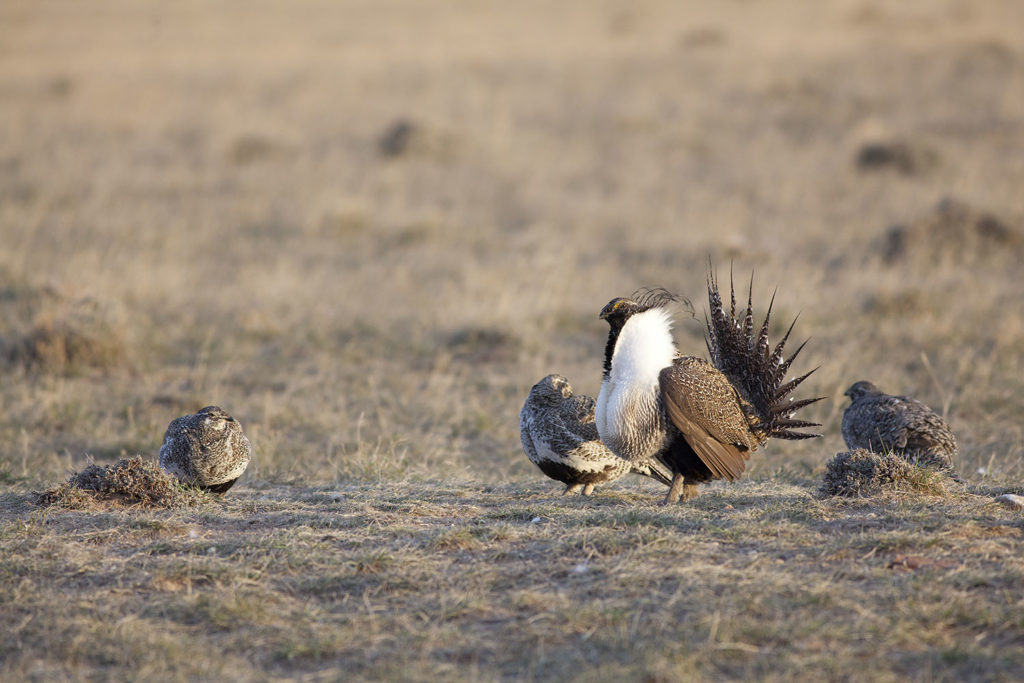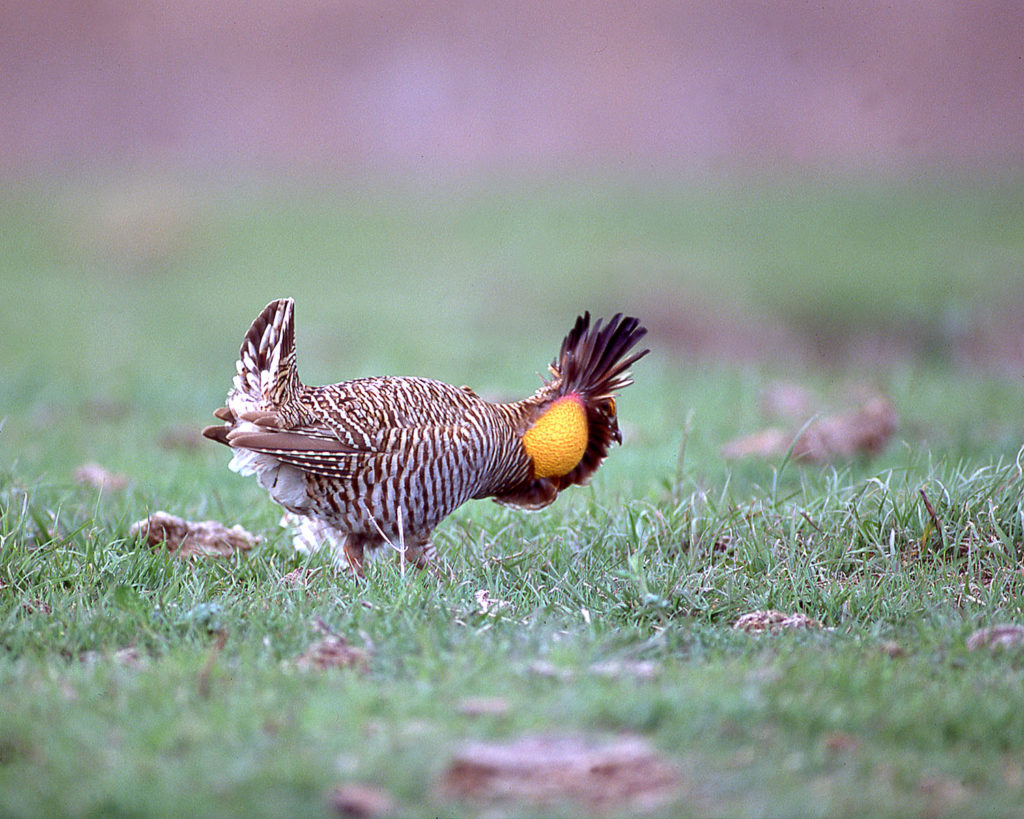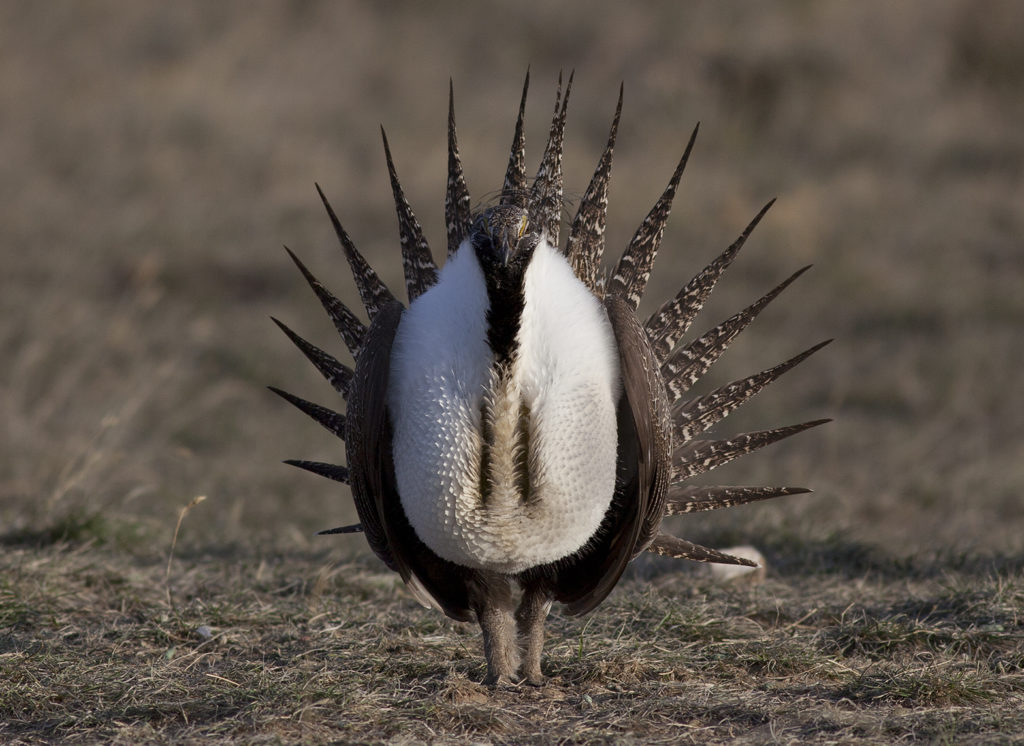
Hen sage grouse visit dominant male on a spring breeding ground. copyright 2016 by Chris Madson, all rights reserved.
ON MARCH 1, THE WYOMING LEGISLATURE PASSED A LAW ALLOWING GAME BIRD FARMS TO take sage grouse and their eggs from the wild in order to produce birds in captivity. Professional wildlife biologists were nearly unanimous in their opposition to the proposal, so much so that Wyoming Governor Matt Mead allowed it to become law without his signature, explaining that he had “considerable reservations with this new bill.”[i]
In the wake of Wyoming’s legislative action, Ryan Zinke, the Trump administration’s new secretary of the interior, issued an order on June 8 calling for a 60-day review of the sage-grouse management plan[ii], the plan that was adopted in 2015 after years of intense debate and collaboration involving hundreds of western residents from a spectrum of backgrounds as well as representatives of local, state, and federal government, the plan that was instrumental in convincing the U.S. Fish and Wildlife Service to keep the greater sage grouse off the list of federally threatened species. Among other goals, Zinke’s order singled out captive breeding of sage grouse as a possible way to “maintain and improve the current population.”[iii]
Captive breeding of sage grouse was a bad idea when it was proposed in the Wyoming legislature, as scores of wildlife professionals pointed out. It was a bad idea when it became law, as Governor Matt Mead pointed out. And it remains a bad idea, in spite of Secretary Zinke’s interest and tacit support. Here’s why:
Captive breeding is a last-ditch step in the effort to hold onto an endangered species, an expensive, risky approach that has some chance of working when the habitat that supported the species is still available and practically none at all if there is no habitat left. Captive breeding has been of significant use in the effort to hold onto highly endangered animals like the California condor, the whooping crane, and the black-footed ferret and very little use for species like the red wolf and the Florida panther.
There are several reasons biologists try to avoid using captive breeding. Sensitive species often don’t survive captivity, and when they do, they often refuse to breed or raise their young. Young animals that are raised by people often fail to imprint on their own kind and won’t breed at all. Young animals raised by closely related species, like young whooping cranes raised by sandhill crane adults, get mixed up about their identity and won’t breed with other members of their own species. Young animals raised in captivity often lack the most basic survival skills, like choosing the right foods in the wild, avoiding predators, or finding shelter in extreme weather. Finally, if the habitat that originally supported the species is rare or has disappeared entirely, there is no place to put animals that are produced in captivity.
The challenges of maintaining populations of rare birds are nowhere more obvious than among America’s grassland grouse. The heath hen is extinct; the Gunnison’s sage grouse is on the federal list of threatened species[iv]; the lesser prairie chicken and Columbian sharp-tailed grouse have both been proposed for threatened status under federal law, and the Attwater’s prairie chicken, a permanent occupant of the federal endangered species list since its inception, has now declined to a population of 42 birds in the wild.
When considering a captive breeding program for any grassland grouse, the case of the Attwater’s is worth review. This subspecies of the greater prairie chicken was included on the very first American list of endangered species in 1967. At that point, its population was in free fall from a presettlement high of as many as 120,000 birds[v] to barely 1,000[vi]. Nor did the collapse end there, even after a national wildlife refuge was created to protect some of the last scraps of remaining Attwater’s habitat in 1972[vii]. By 1990, biologists could find only 470 birds.[viii]

A male Attwater’s prairie chicken displaying on one of the species’ last breeding grounds in southern Texas. Copyright 2015 Chris Madson, all rights reserved.
Faced with this precipitous decline, wildlife managers decided to begin a captive breeding effort in 1992. It took a while to find a regime the birds would tolerate. In the first five years, the facility produced an average of 44 young birds per year. The first captive-raised birds were released to the wild in 1996, and over the next four years, the average number of birds produced rose to 66 per year. Between 2012 and 2016, production increased again, to more than 300 birds per year.[ix]
Numbers of Attwater’s prairie chickens in the wild have bounced around in the years since the release of captive birds began. The population dropped as low as 40 birds in 2002, rose, then dropped back to 40 in 2005. In 2016, it hit a modern high of 130, but a major flood that year hit the birds hard. The 2017 count was back to 42 birds.[x]
There’s little doubt that the subspecies would be gone if it hadn’t been for the steady supply of captive-reared birds. Let me repeat that: The Attwater’s prairie chicken would almost certainly be extinct if it hadn’t been for the research, commitment, and persistence of a group of scientists and technicians who overcame many of the barriers to keeping the birds in captivity, getting them to breed, and raising young prairie chickens to flight stage. These conservationists have worked a minor miracle.
However, it’s also clear that 25 years of captive breeding and consistent introduction of pen-reared birds, combined with all the other management efforts, have not been enough to move the Attwater’s prairie chicken out of danger— 42 birds in 1996; 42 birds in 2017.[xi] Right back where they started. Drought, hurricanes, floods, and the invasion of an exotic insect, the fire ant, have all set back the recovery, and beyond these environmental shocks, there are indications that the captive-reared Attwater’s chickens are weaker than their wild brethren.
Research suggests that there are differences in the function of the immune systems of Attwater’s prairie chickens in the wild and those raised in captivity, differences that could affect survival of captive birds when they are released and possibly even the survival of any chicks they produced.[xii] Other investigators report that Attwater’s prairie chickens raised in captivity are less alarmed by the approach of a dog and don’t fly as far as other prairie chickens when they’re disturbed. The difference apparently lasts throughout their lives and may well mean that the captive-reared birds are more vulnerable to predators.[xiii]
And the hard truth is that there aren’t many places left to put captive-reared Attwater’s prairie chickens. Val Lehman, the first researcher to take a hard look at the bird, estimated that, in good years, there were around 6 million acres of Attwater’s prairie chicken habitat.[xiv] These days, there are between 100,000 and 200,000 acres left, depending on how you count, or roughly three percent of the original.[xv]
Beyond these biological issues, there is the matter of cost. Several private-sector conservation facilities house captive-rearing programs for Attwater’s prairie chickens, and all these organizations help fund the effort, which makes it hard to estimate the actual cost. At least one authority on the Attwater’s program has been quoted as saying that the released birds run about $1,000 each,[xvi] and that may well be a conservative figure, since it doesn’t include the start-up costs of the captive breeding program or construction of the buildings that house it.
That’s what a captive breeding program looks like, and it’s why biologists suggest captive breeding only as a last resort when a species is in imminent danger of extinction.
The situation facing greater sage grouse is worrisome, without doubt. Half the bird’s range has been destroyed, and much of what remains is in no better than fair condition[xvii]. New diseases like West Nile virus also pose a threat.[xviii] Still, there are between 200,000 and 500,000 sage grouse left[xix] and about 120 million acres of

A male sage grouse displays on a communal spring breeding ground. Copyright 2016 Chris Madson, all rights reserved.
occupied habitat.[xx] The opportunity to influence management on these lands is much greater than it is in Attwater’s prairie chicken habitat, since more than 60 percent of greater sage grouse country is controlled by the Bureau of Land Management and other federal agencies.
With all these reasons to avoid captive breeding of greater sage grouse, why would Secretary Zinke mention it as an area of focus for the team charged with this 60-day review? The secretary’s order offers a chilling motive: He believes captive breeding may allow “energy and other development of public lands . . ., job creation and local economic growth.”[xxi] In other words, he is hoping to find a way to accelerate habitat loss in the West’s sagebrush grasslands, the one trend that really does threaten the future of sage grouse, along with Columbian sharptails, pronghorns, mule deer, and a host of other wild things that depend on the sage.
Alarm over the possibility of a major shift in sage-grouse management has transcended party lines. On May 26, Governor Mead, a dyed-in-the-wool Wyoming Republican, and Colorado Governor John Hickenlooper, a twenty-first-century western Democrat, co-signed a letter to Secretary Zinke expressing their worry over the possibility that he might make major changes to the sage grouse management plan currently in place without consulting the many interest groups that helped forge the agreement.
“We are concerned,” they wrote, “that this is not the right decision.”
I share the governors’ concern. The management approach for sage grouse that is being followed today is the product of an intense negotiation that stretched over several years and involved all points of view. Upsetting that delicate consensus now would be a severe blow to sage grouse and the sagebrush grasslands on which they depend. And adopting a captive-breeding effort to justify accelerated industrial incursions into the sagebrush wilderness is, at best, an act of ignorance and, at worst, a cynical perversion of science and conservation to benefit a well-heeled special interest.
Sage grouse don’t need help with their love lives— they handle that just fine on their own. What they need is a place to live, a landscape that provides food, water, and shelter, secure nurseries, refuge from blizzards and drought. The key to the future of sage grouse is habitat, not captive breeding.
And we hold the key in our hands.
[i] Letter from Governor Matt Mead to The Honorable Edward Murray, Wyoming Secretary of State, regarding Enrolled Act No. 0091 — Original HB0271 Game bird farms — greater sage grouse. March 14, 2017.
[ii] Order No. 3353, Secretary of the Interior, Washington, D.C. June 8, 2017.
[iii] Order 3353, page 3, lines 18-21.
[iv] ECOS Environmental Conservation Online System, U.S. Fish and Wildlife Service. https://ecos.fws.gov/ecp0/pub/SpeciesReport.do?dcomname=1&searchstring=sage-grouse&action=generate&outgrouped=false&outformat=html&outtype=species&dsciname=0&dgroup=2&dstatus=3&dinvname=-1&dspcode=-1&dfamily=-1&ddate=-1&dleadreg=-1&drange=-1&dregions=-1&dmapstatus=-1&dvip=-1&dinvpop=-1&dcrithab=-1&dspecrule=-1&dstates=-1&dwl=-1&sgroup=0&ssciname=1&scomname=2&sinvname=-1&sspcode=-1&sfamily=-1&sdate=-1&searchkey=comname&searchkey=sciname&header=Results+of+Species+Search&s8fid2=24012698821181&s8fid2=112761032791&s8fid2=112762573891. Consulted on July 22, 2017.
[v] Johnsgaard, Paul A., 2002. Grassland Grouse and Their Conservation. Smithsonian Institution Press, Washington, D.C. p. 20.
[vi] Attwater’s prairie chicken count data provided by Terry Rossignol, manager at the Attwater’s Prairie Chicken National Wildlife Refuge.
[vii] Johnsgaard, p. 26.
[viii] APCNWR data.
[ix] Personal communication, Terry Rossignol, manager of the Attwater’s Prairie Chicken National Wildlife Refuge, July 19, 2017.
[x] APCNW data and personal communication with Terry Rossignol.
[xi] APCNWR data.
[xii] Meier, S.A., C.A. Fassbinder-Orth, and W.H. Karasov, 2013. Ontogenetic changes in innate immune function in captive and wild subspecies of prairie chickens. Journal of Wildlife Management 77(3): 633-638.
[xiii] Hess, M.F., N.J. Silvy, C.P. Griffin, R.R. Lopez, and D.S. Davis, 2005. Differences in flight characteristics of pen-reared and wild prairie chickens. Journal of Wildlife Management 69(2): 650-654.
[xiv] Lehmann, V.W. 1941. Attwater’s prairie chicken: Its life history and management. U.S. Government Printing Office, Washington, D.C. p. 4.
[xv] Bergan, J., M. Morrow, and T. Rossignol, 2010. Attwater’s prairie chicken recovery plan, second revision. U.S. Fish and Wildlife Service, Albuquerque, NM. pp. 28-29.
[xvi] Pearce, Michael, 2014. Prairie chicken propagation plan has risks. Wichita Eagle-Beacon, July 19, 2014.
[xvii] Public Employees for Environmental Responsibility BLM Rangeland Health Standards Mapping Project https://mangomap.com/pdl/maps/24736/BLM%20RANGELAND%20HEALTH%20STANDARDS%20EVALUATION%20DATA%20(2012)?preview=true#zoom=6&lat=35.844535&lng=-111.851807&layergroups=pdl%3Afd2d4cda-6549-11e4-a90b-22000b2517a0,pdl%3A881e3858-596b-11e4-a105-22000b2517a0&isNewLayer=false&hostPermalinkEnable=false&bck=bingmap, viewed July 23, 2017.
[xviii] Taylor, R.L., J.D. Tack, D.E. Naugle, and L.S. Mills, 2013. Combined effects of energy development and disease on grater sage-grouse. PLOS One 8(8): e71256.
[xix] U.S. Fish and Wildlife Service fact sheet: https://www.fws.gov/greatersagegrouse/factsheets/GreaterSageGrouseCanon_FINAL.pdf Viewed July 23, 2017.
[xx] Knick, S.T. and J.W. Connelly, 2011. Greater sage-grouse: Ecology and conservation of a landscape species and its habitats. University of California Press, Berkeley, CA.
[xxi] Order No. 3353, Secretary of the Interior Ryan Zinke, June 8, 2017. p. .3.
Leave a Reply
You must be logged in to post a comment.